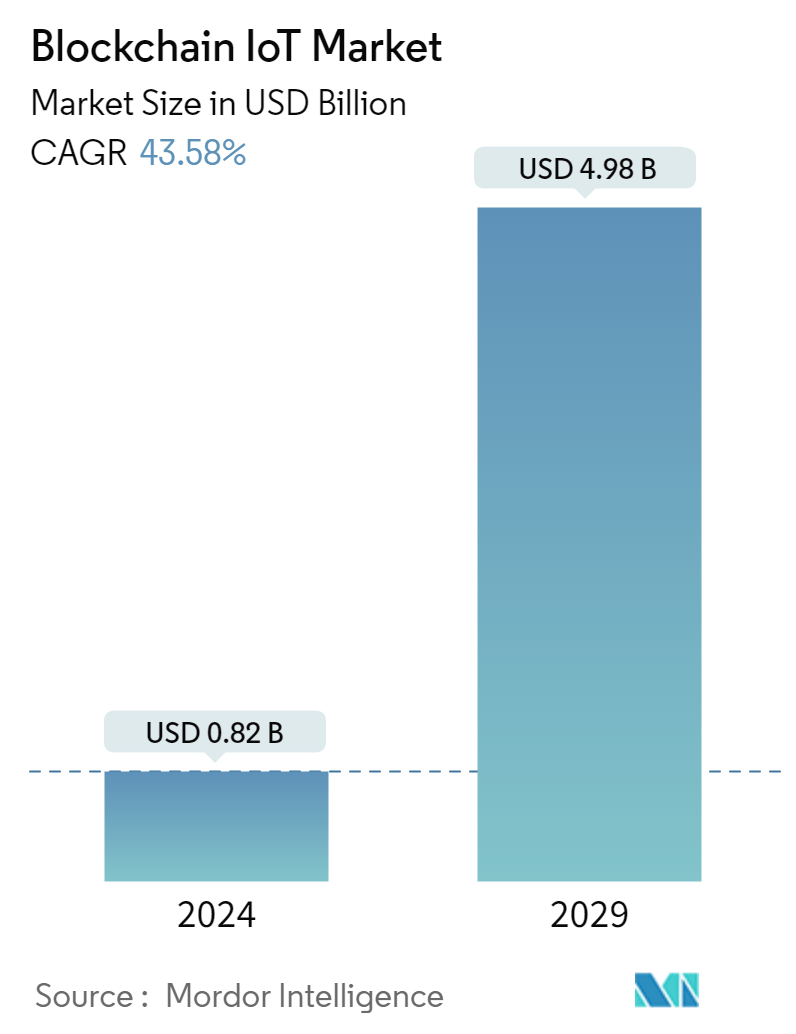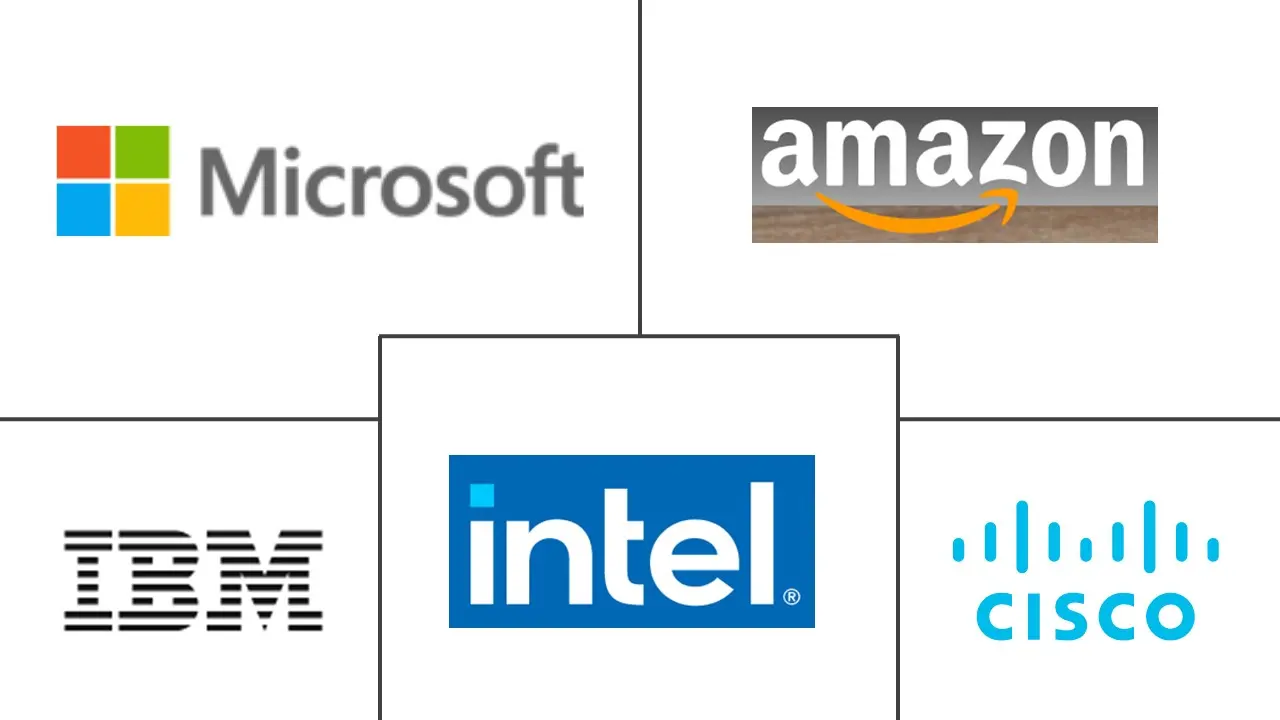Market Size of Blockchain IoT Industry

| Study Period | 2019 - 2029 |
| Market Size (2024) | USD 0.82 Billion |
| Market Size (2029) | USD 4.98 Billion |
| CAGR (2024 - 2029) | 43.58 % |
| Fastest Growing Market | Asia Pacific |
| Largest Market | North America |
| Market Concentration | Low |
Major Players
*Disclaimer: Major Players sorted in no particular order |
Blockchain IoT Market Analysis
The Blockchain IoT Market size is estimated at USD 0.82 billion in 2024, and is expected to reach USD 4.98 billion by 2029, growing at a CAGR of 43.58% during the forecast period (2024-2029).
The convergence of blockchain and IoT (Internet of Things) is transforming industries by providing enhanced security, transparency, and efficiency. As the IoT ecosystem continues to grow, so does the demand for secure and reliable data management, driving the adoption of blockchain technology. Blockchain IoT applications are increasingly seen as vital solutions for addressing challenges like data integrity, privacy, and authentication in connected devices.
Industry Adoption and Applications
- Manufacturing and Supply Chain: Industries such as manufacturing, energy utilities, transportation, and smart cities are adopting blockchain IoT solutions to streamline operations and enhance security. Blockchain in IoT is particularly valuable in supply chain management, where it ensures transparent tracking of assets and secure data sharing among stakeholders. Additionally, blockchain IoT integration supports smart contracts and data communication, offering automated, tamper-proof solutions that reduce costs and improve efficiency.
- Data Integrity and Security: The architecture of Blockchain IoT combines decentralized ledger technology with IoT devices, creating a network where data is securely processed and stored across multiple nodes. This decentralized approach mitigates the risk of single points of failure, making it a robust solution for critical applications such as asset tracking and data management.
Enhanced Security Needs in the IoT Ecosystem
- Decentralized Security: As the IoT landscape expands, security concerns become increasingly critical. IoT devices, by nature, are often vulnerable to cyber-attacks due to their distributed and interconnected structure. The growing need for IoT security with blockchain has made this technology an essential component in safeguarding these networks.
- Tamper-Proof Data Storage: Blockchain technology provides a decentralized framework, enhancing the security of IoT networks. Blockchain’s immutable ledger ensures that once data is recorded, it cannot be altered or deleted without consensus. This feature is crucial for IoT applications that require high levels of data integrity, such as in healthcare or financial services.
- Authentication and Authorization: Blockchain enables secure authentication of IoT devices, ensuring that only authorized entities can access the network. Smart contracts can automate this process, providing a seamless and secure method for managing access rights and permissions across a diverse set of devices.
Challenges of Scalability and Processing Power
- Scalability Issues: While the potential of blockchain IoT is immense, there are significant challenges related to scalability, processing power, and storage. Blockchain networks, by design, require all participating nodes to validate transactions. This can slow down the processing speed, especially as the number of IoT devices increases, leading to bottlenecks and making real-time data processing challenging.
- Processing Power Requirements: Blockchain's cryptographic algorithms require substantial computational resources, which can be a limitation for IoT devices with limited processing capabilities. These devices may struggle to perform the necessary cryptographic functions, particularly in resource-constrained environments.
- Storage Constraints: Blockchain's distributed ledger can grow significantly in size over time, presenting storage challenges, especially for IoT devices with limited storage capacity. This issue is compounded in applications where data needs to be stored long-term, such as in asset tracking and historical data analysis.
Blockchain IoT Industry Segmentation
Blockchain, at its core, is a cryptographically secured, decentralized, distributed public ledger that allows users within the network to transfer data between parties, where miners verify the transaction before entering the chain. In contrast, IoT systems, with their centralized architecture, allow data transfer from devices to a central authority. The integration of both technologies led to the development of blockchain IoT platforms, such as IOTA, a platform designed for IoT to provide data transfer and transaction settlement between connected devices. Similar platforms include VeChain, Waltonchain, and Hdac.
The blockchain IoT market is segmented by offering (hardware, software, infrastructure), application (data security, smart contracts, data communication, asset tracking and management, and other applications), end user (manufacturing, energy utility, transportation and logistics, building management, retail, smart city), and geography (North America (United States, Canada), Europe (Germany, United Kingdom, France, Rest of Europe), Asia-Pacific (India, China, Japan, Rest of Asia-Pacific), Latin America, Middle East and Africa).The market sizes and forecasts are provided in terms of value in USD for all the above segments.
Core Offerings: The Blockchain IoT market is segmented by offering, application, end-user, and geography. Hardware, software, and infrastructure components form the core offerings, with applications ranging from data security and smart contracts to asset management.
Regional Leadership: Regionally, North America, particularly the United States, is a key market due to the early adoption of IoT and blockchain technologies. Europe and Asia-Pacific also show significant potential, with countries like Germany, the United Kingdom, China, and Japan leading in blockchain IoT implementations. Each region presents unique opportunities and challenges, influenced by factors such as regulatory environments, technological infrastructure, and market maturity.
| By Offering | |
| Hardware | |
| Software | |
| Infrastructure |
| By Application | |
| Data Security | |
| Smart Contracts | |
| Data Communication | |
| Asset Tracking and Management | |
| Other Applications |
| By End User | |
| Manufacturing | |
| Energy Utility | |
| Transportation and Logistics | |
| Building Management | |
| Retail | |
| Smart City |
| By Geography*** | |||||
| |||||
| |||||
| |||||
| Australia and New Zealand | |||||
| Latin America | |||||
| Middle East and Africa |
Blockchain IoT Market Size Summary
The blockchain IoT market is poised for significant growth, driven by the integration of blockchain technology with the Internet of Things (IoT). This convergence aims to enhance security and privacy through decentralized architecture and cryptographic encryptions, addressing the vulnerabilities of traditional centralized IoT systems. As IoT technology matures, the demand for secure and efficient data management solutions becomes paramount, particularly in sectors like healthcare, government, and smart city initiatives. The COVID-19 pandemic has accelerated the reliance on digital solutions, highlighting the importance of secure IoT systems in various industries. Despite challenges such as high computational power requirements and data storage limitations, the potential for blockchain IoT to provide robust security and transparency is a key factor driving market expansion.
The market landscape is characterized by the presence of major players such as IBM, Intel, Microsoft, Cisco, and Amazon, who are actively engaging in partnerships, innovations, and strategic acquisitions to strengthen their market position. The Asia-Pacific region is expected to experience the highest growth rate, fueled by urbanization, government initiatives, and investments in smart city projects. These developments underscore the critical role of blockchain IoT in managing urban growth and resource optimization. Additionally, global investments in smart city infrastructure are anticipated to rise, further propelling the demand for blockchain IoT solutions. As governments and enterprises increasingly recognize the benefits of blockchain technology, the market is set to witness substantial advancements and adoption across various sectors.
Blockchain IoT Market Size - Table of Contents
-
1. MARKET INSIGHTS
-
1.1 Market Overview
-
1.2 Industry Attractiveness - Porter's Five Forces Analysis
-
1.2.1 Threat of New Entrants
-
1.2.2 Bargaining Power of Buyers/Consumers
-
1.2.3 Bargaining Power of Suppliers
-
1.2.4 Threat of Substitute Products
-
1.2.5 Intensity of Competitive Rivalry
-
-
1.3 Value Chain/Supply Chain Analysis
-
1.4 Assessment of Impact of COVID-19 on the Industry
-
-
2. MARKET SEGMENTATION
-
2.1 By Offering
-
2.1.1 Hardware
-
2.1.2 Software
-
2.1.3 Infrastructure
-
-
2.2 By Application
-
2.2.1 Data Security
-
2.2.2 Smart Contracts
-
2.2.3 Data Communication
-
2.2.4 Asset Tracking and Management
-
2.2.5 Other Applications
-
-
2.3 By End User
-
2.3.1 Manufacturing
-
2.3.2 Energy Utility
-
2.3.3 Transportation and Logistics
-
2.3.4 Building Management
-
2.3.5 Retail
-
2.3.6 Smart City
-
-
2.4 By Geography***
-
2.4.1 North America
-
2.4.1.1 United States
-
2.4.1.2 Canada
-
-
2.4.2 Europe
-
2.4.2.1 Germany
-
2.4.2.2 United Kingdom
-
2.4.2.3 France
-
-
2.4.3 Asia
-
2.4.3.1 India
-
2.4.3.2 China
-
2.4.3.3 Japan
-
-
2.4.4 Australia and New Zealand
-
2.4.5 Latin America
-
2.4.6 Middle East and Africa
-
-
Blockchain IoT Market Size FAQs
How big is the Blockchain IoT Market?
The Blockchain IoT Market size is expected to reach USD 0.82 billion in 2024 and grow at a CAGR of 43.58% to reach USD 4.98 billion by 2029.
What is the current Blockchain IoT Market size?
In 2024, the Blockchain IoT Market size is expected to reach USD 0.82 billion.

